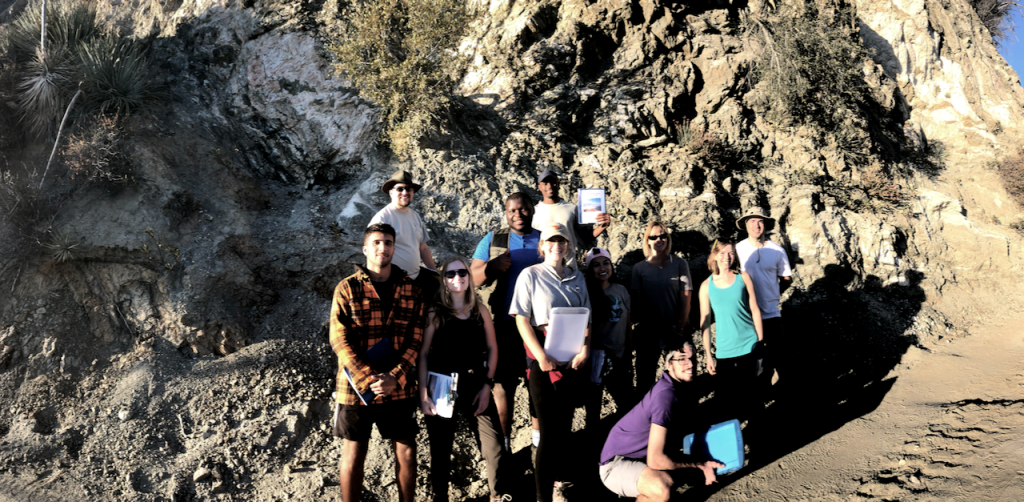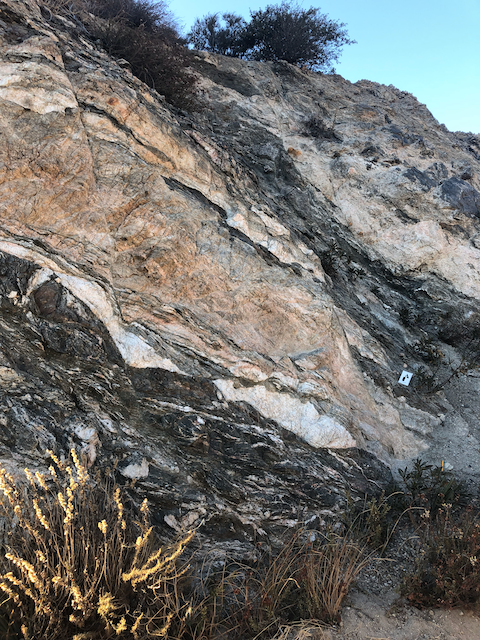Stop 1: Blue Cut, Punchbowl Fault, Cajon Pass
The Punchbowl Fault is an exhumed, inactive fault that gives us the opportunity to view up close what fault zones look like within the seismogenic part of the crust. Offset structural and stratigraphic features across the fault indicate that the fault accommodated ~44 km of right-lateral offset (Dibblee, 1968, Weldon et al., 1993). The Punchbowl fault was active 1-4 Ma (at the time, it was likely the active strand accommodating a significant component of the strike slip offset now accommodated by the San Andreas). However, deformation associated with shortening in the restraining bend region of the San Andreas System has caused this segment to be deformed, uplifted, and eventually abandoned in favor of slip on the San Andreas which now runs ~5 km to the north of this fault.

Based on the thickness of overlying sediment, it can be inferred that the portion of the fault that we now can see at the earth’s surface has been exhumed from 2-4 km depth (Chester and Logan, 1986, 1987). Therefore, this stop gives us the opportunity to see what fault zones look like within the seismogenic part of the crust. At this location, the fault is ~30 m wide. The fault core consists of anastomosing gouge and cataclasite layers less than 2 cm thick, bounded by slip planes with strike-slip slickenlines. Adjacent to the core, slip surfaces and veins decrease in density with distance away from the fault core. Though the bulk chemistry of the fault zone and host rock are similar at this site, the fault zone is slightly depleted in Al2O3, TiO2, and Na2O, and is enriched in MgO. A high degree of geochemical alteration, likely facilitated by fluids, is also observed closer to the fault core (Schulz and Evans, 1998).
The fault core consists of anastomosing gouge and cataclasite layers less than 2 cm thick, bounded by slip planes with strike-slip slickenlines. Adjacent to the core, slip surfaces and veins decrease in density with distance away from the fault core. Though the bulk chemistry of the fault zone and host rock are similar at this site, the fault zone is slightly depleted in Al2O3, TiO2, and Na2O, and is enriched in MgO. A high degree of geochemical alteration, likely facilitated by fluids, is also observed closer to the fault core (Schulz and Evans, 1998).
Stop 2: San Andreas Fault at Cajon Pass


At this location, we can see an outcrop of the San Andreas fault where it juxtaposes the Pelona Schist against an unnamed Tertiary sandstone (Weldon, 1987, Jordan et al., 2005). The fault zone is sheared and foliated and primarily cataclastic in nature.
Also note the juxtaposition of brittle strain over more ductile deformation in the Pelona Schist within the fault damage zone on the western side of the fault. From this location, looking back toward the direction we came from (NW), we can see the San Andreas fault as it traces through Lone Pine Canyon (Figure 1.5). We can see a small lake, called Lost Lake, which is a sag pond associated with a minor releasing bend geometry in the fault at that location.